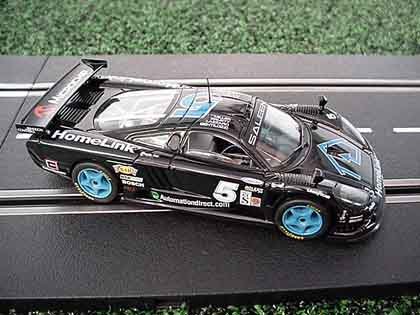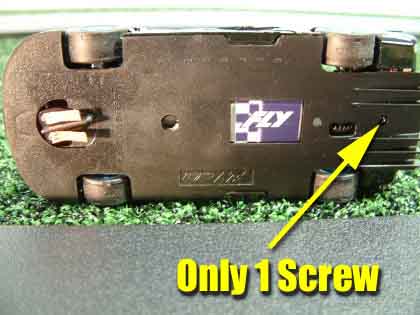
January 10, 2003
![]()
THE FLY SALEEN S7R 24 HOURS DAYTONA 2001
![]()
Finally it has arrived. I can't think of too many FLY models more enthusiasts have been waiting for than the Saleen S7R. I myself looked forward to this incredible American Supercar, and hoped that this time Fly managed a decent balance of mechanical effort along with great detail. Did they pull it off?

As I opened the case, the detail just reaches out and grabs you. Folks, this car is beautiful. From the molded body and hood latches, to the metal intake screening, it impressed me. Mold lines and body fit were clean and precise. I found one small problem with the outer detail as the rear center light was mounted crooked. I used a needle-nose pliers and straightened this out easily. Some flash molding was noticed on the rear wing as well, but it took me awhile to notice it. Nit-picking I know, but for some these are important items so I mention them.
From the headlights to the adjustable rear wing, Fly has really produced a great model. This rear wing swivels back and then easily pops off. This should prolong the life of it in hard crashes, but only time will tell that tale. The front mirrors and antenna will most likely live short lives (Like some of my Listers) if you don't keep this car in the slot. Tampo-stampings were some of the finest I have seen by Fly. I found only one VERY small fade of white on the right quarter-panel Cutler-Hammer logo. Other than that, the rest were perfect.
I guess they purchased a new vacuum or ventilation system in the Fly clear-coat division, because this car had no evidence of dirt or dust anywhere on the model. The clear-coat was even, with no orange peel detected, and I am happy to see it. However, lets don't forget about the interior.
From the outside of the car, you can see that Fly isn't letting up in the detail department. The interior is very well done, at least in my eyes, even the fire bottle had decent Tampo-markings. A full driver figure along with very nice roll-cage work and dashboard markings really draw your attention. To the rear you can see the engine detail, along with cross-bracing, and if you even look closer you can see the exhaust piping as well.
Well, I will let the photos do the talking as I should, and let you make up your own mind. There are far more enthusiasts who know a great deal more of the 1:1 specifications than I. With this said, after looking at prototype photos, I think Fly comes very close in its 1/32nd scale representation. It might not be perfectly to scale, but if I can't tell the difference while it is sitting on the track, and enjoy driving it, 100% scale accuracy doesn't factor in as heavy for me as it does for some.

Now with all this detail, you can might imagine it would be difficult to take apart. Well, it is slightly tricky, but not as bad as the 917/10, at least in my eyes. First, there is only ONE screw that holds the body to the chassis. Once removed, spread the body apart at the sides where you see the body tabs, and once you see it release, push the body forward to clear the detail assembly. It will make a popping sound upon removal, and it almost will make you think you broke it...but after doing this about 10-15 times now with no problems, you should find that no harm is done.
After the body is removed you can see the engine detail completely. Removal of this is easier than you might expect however. First remove the top assembly as shown in the photo. Then you have your exhaust pipes in 2 sections, and finally the mount all this detail is attached to. The mount simply snaps in place, and at least on my model, was not glued in place (thankfully). Some might question all this added detail, and I guess you could always remove it. For our home racing, the added weight that the detail adds isn't nearly enough of a factor to cause me to remove it.
Now you can see the newer Fly racing motor rated between 26 and 27,000 rpms. Directly to the rear of the motor is the standard Fly bar magnet, that simply snaps in place. This snap-in mount is very tight, but I find it to be a better design than the older post and bracket type mounts. Rounding out the rear is a 9 tooth pinion and 27 tooth crown gear and brass bushings for the rear axle. Gear mesh was very smooth and there was no side to side free-play present. At first, this car had a slight chatter to it, but after 30-40 laps of breaking in, this subsided noticeably.

The front guide seemed a better fit than previous models, although there was some slight free-play. I did notice in my testing that this car can de-slot a little easier than I expected. The front axle seems to be mounted a little lower causing the guide to ride just slightly higher than flush, and you can see the ride height of the body. This should accommodate just enough room for this modification. Rather than take out my milling tool and enlarge the axle mount holes, I chose a different and quicker way (cheated).
There is just enough room to install 2 Radio Shack button magnets as shown in the photo. This helped pin this front end down, and my de-slotting woes were soon ended. This is in no way the best way, but most folks have a Radio Shack nearby, and can easily get these magnets. I think that having the front axle mount holes enlarged is the better way to go however, and I will perform this later. This axle mount, which does not allow for the axle to float over some of the bumpier areas on your track cause the car's front end to raise and lower quite visibly. I also noticed some side to side free-play in the front axle, but you can twist these front wheels in until you have no free-play whatsoever.
But how does it run? The first Fly BMW was a stunner as well, but failures with the gearing plagued it with problems, taking away from all that detail. So I was hoping for the best with this anticipated model. When the rubber finally met the road, I was happy to find a quick and responsive model. Braking was crisp, of course a strong magnet increases this action, and the stronger motor provided plenty of punch in the straights. On all 3 track systems tested; Artin, Carrera and Scalextric Sport, this car handled quite well. I found that I started to enjoy this car more and more while we broke it in. Diving deep into the corners and punching on the gas provided a little tail-out action that became quite addicting. We found that the Fly Corvettes and Listers were both great match-ups for this model as well, even with the Saleen having a little extra motor.
Just about every slot car produced requires a little work to get it to perform the way YOU think it should. With that said, in the end, I must give this model a decent grade. Great detail combined with a smooth drive-train usually equals a good slot car. I think Fly has accomplished this, at least in my personal findings with my model. It isn't perfect, and I am sure some will find enough faults not to recommend it. I am not one of them however, and regardless of any of the issues noted, I like this car and we are going to have fun racing it. I will say it is better suited for the adult modeler than younger children, but I still have to recommend this model, not only to fans of the series, but to most any slot car enthusiast.
Harry
As always, feel free to email me at wiseone@yhti.net about this article or just the hobby in general.
Or better still, drop into the Home Racing World Message Forum and let us know your thoughts.
A thanks goes to Slot Car World for providing me with this excellent model.